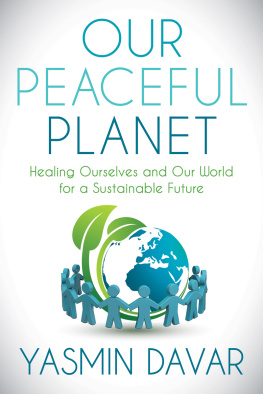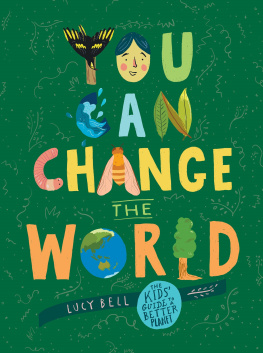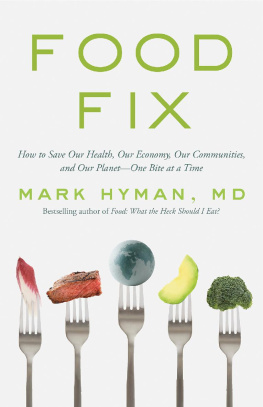OUR PEACEFUL PLANET
OUR
PEACEFUL
PLANET
Healing Ourselves and Our World
for a Sustainable Future
YASMIN DAVAR

NEW YORK
NASHVILLE MELBOURNE VANCOUVER
OUR PEACEFUL PLANET
Healing Ourselves and Our World for a Sustainable Future
2017 YASMIN DAVAR
All rights reserved. No portion of this book may be reproduced, stored in a retrieval system, or transmitted in any form or by any meanselectronic, mechanical, photocopy, recording, scanning, or otherexcept for brief quotations in critical reviews or articles, without the prior written permission of the publisher.
Published in New York, New York, by Morgan James Publishing. Morgan James and The Entrepreneurial Publisher are trademarks of Morgan James, LLC. www.MorganJamesPublishing.com
The Morgan James Speakers Group can bring authors to your live event. For more information or to book an event visit The Morgan James Speakers Group at www.TheMorganJamesSpeakersGroup.com.
ISBN 978-1-68350-240-1 paperback
ISBN 978-1-68350-242-5 eBook
ISBN 978-1-68350-241-8 hardcover
Library of Congress Control Number: 2016915420
Cover Design by:
Rachel Lopez
www.r2cdesign.com
Interior Design by:
Bonnie Bushman
The Whole Caboodle Graphic Design

In an effort to support local communities, raise awareness and funds, Morgan James Publishing donates a percentage of all book sales for the life of each book to Habitat for Humanity Peninsula and Greater Williamsburg.
Get involved today! Visit
www.MorganJamesBuilds.com
PREFACE
My hope is that the ideas contained in these pages inspire you to think differently about yourself, the people in your world, and the world we live in. Beyond that, I hope your changed perceptions compel you to approach your life, the lives of others, and the earth in ways that lead to greater harmony, love, and respect.
Introduction
THE CASE FOR CHANGE
The Chernobyl disaster of April 26, 1986 had an incredible impact on my twelve-year-old self. What a terrible thing to happen, devastating the lives of many people and impacting the environment for many years to come. The Cold War was in full flight at the time, and every day on the news we heard about the latest nuclear arms build-up and posturing between the United States and the former Soviet Union. Even at that young age, I thought that there must be a better way to do things. Surely we do not need to be so unkind to each other and rely on technologies that ravage the environment?
This question has led me, through a degree in Environmental Engineering and another in International Relations in Peace and Conflict Resolution, through work in both fields and in the corporate world, to the ideas that are contained in this book.
I am not sure that we have progressed far since that accident in 1986. While we have had major breakthroughs with the end of the Cold War and the dismantling of apartheid, as I write this, conflicts are being fought in Syria and Iraq, and Israel and Palestine still have not come to a resolution. Many people are denied the right to choose their leaders, and millions live in poverty despite the enormous wealth in the world. The 2011 Fukushima nuclear power plant disaster in Japan will have social and environmental impacts for years to come. Rainforests in Asia and South America are being destroyed for the production of palm oil and beef. The effects of climate change are being felt by people and ecosystems across the world.
Is this the way we want to keep going? I am by no means suggesting an apocalyptic end to the world with a massive world war and our environment completely ravaged by our endless consumerism. What I see, and many of you see as well, is a gradual (and sometimes not gradual) decline in the well-being of many people and the environment. Where will we find ourselves at the end of this decline, and will this be where we want to be?
Rather than blindly sliding down that slippery slope, lets assume that we have control over the outcome. If we could choose what our planet looks like in ten, twenty, or fifty years time, what would we choose? I believe that the most popular answer would be a world where we live in peace and harmony with each other and our environment, where the well-being of all living things is high.
Some might say that this world is a fantasy. I disagree. This world is completely within our reach, and this book sets out what we can do to realize it. It covers how we can consciously change our beliefs and behaviors, and what modifications we can make to existing governance, industrial, and economic systems to enable greater harmony, equality, and well-being.
You may think that you, as only one person, can have little impact on the world. This is not true. Many of us work in areas where we can influence change at local, national, and international levels. Many of us work in industries that are not as kind to the environment as they could be. A great many of us can influence the behavior of governments and corporations through both our voting and purchasing power. And all of us have the power to change our own beliefs and behaviors. This is the greatest power of all, and is where we will start.
PART 1
HEALING OURSELVES


HEALING FROM THE INSIDE OUT
Given the opportunity, most of us would welcome the chance to live happier and more meaningful lives. It naturally follows that if we want the world to be a happier place and for people to live in peace, then each of us needs to be happier and more at peace within ourselves. This is because we project everything we have inside of us out into the world. Both pain and happiness ripple out from us in direct proportion to the amounts of each that we carry inside. This is why change starts with each of us first, even though it may seem that changes in others, or at a national or international level, are more important.
Its easy to blame others our parents, our partner, our boss, the government, or people from another country or group for things that seem outside of our control. We sometimes overlook the part we play in our everyday interactions. We forget how much power each of us has in shaping our own lives, the lives of those around us, and the world in which we live. The way we react to situations, the roles we play, the choices we make, and whether we take responsibility for these things, all directly shape our world.
Change in the world can only happen when each of us takes responsibility for our impact on the world. It is up to each of us to heal our internal pain and the negative beliefs behind that pain, so that more peace and happiness ripple out from within. In this way, we can then live in greater harmony with ourselves and those around us. The increased happiness in the world provides a stronger foundation to make the changes that are required in our global society, as shown in .
Figure 1:
Our peaceful planet is created by positive change at both the individual and societal levels.














